Monitor the "CAN COMMUNICATION SERVICE DATA (ENGINE RPM, VEHICLE SPEED SENSOR, THROTTLE P. SENSOR)" parameters on the scantool.

Several control units are applied to electronically controlled vehicles. These units perform each control with informations from various sensors. Thus, sharing signal information from sensors is needed, so CAN communication type whose communication speed is high and insensitive to electrical noise by spark generation is adopted to controlling power-train(engine, atutomatic transaxle, ABS, TCS, ECS) As sharing signals of engine speed, APS, engaged gear and torque reduction through CAN communication, ECM and TCM modules control vehicle actively.

The TCM can either receive data from the Engine Control Module or ABS control module, or it can send data to the ECM and ABSCM by using CAN communication. The CAN communicaton is one of the vehicle communications method, which is now widely used to transfer the vehicle data.
U0001 is set when signal transmission through CAN communication line is impossible for more than 0.19 sec. because of open or short to ground in CAN communication line. Checking CAN communication BUS and signals from ECM, TCM module is required.
When the TCM cannot read the data from the ECM through the CAN-BUS line, the TCM sets this code.
CAN-BUS circuit malfunctioning or ECM can be a posssible cause of this DTC.
Item | Detecting Condition | Possible Cause | ||
DTC Strategy | ● Signal monitoring | ● CAN BUS ● CAN communication module component | ||
Enable Conditions | ● IG KEY "ON" | |||
Threshold Value | ● CAN BUS error | |||
Diagnostic Time | ● 190 ms | |||
Fail Safe | Fuel cut | NO | ||
EGR Off | NO | |||
Fuel Limit | NO | |||
Check Lamp | NO | |||
Item | Detecting Condition | Possible cause |
DTC Strategy | ● Check voltage range | ● Open or Short in CAN communication harness ● Faulty ECM ● Faulty TCM |
Enable Conditions | ● Not Fail Safe Status ● IG "ON" ● Ne ≥ 100rpm | |
Threshold value | ● Receive a message "BUS OFF" from CAN MI-COM | |
Diagnostic Time | ||
Fail Safe | ● INTELLIGENT SHIFT and is inhibited ● Learning for oil pressure control is inhibited ● Torque Retard requirement is inhibited ● Direct connection control of TCC is inhibited |
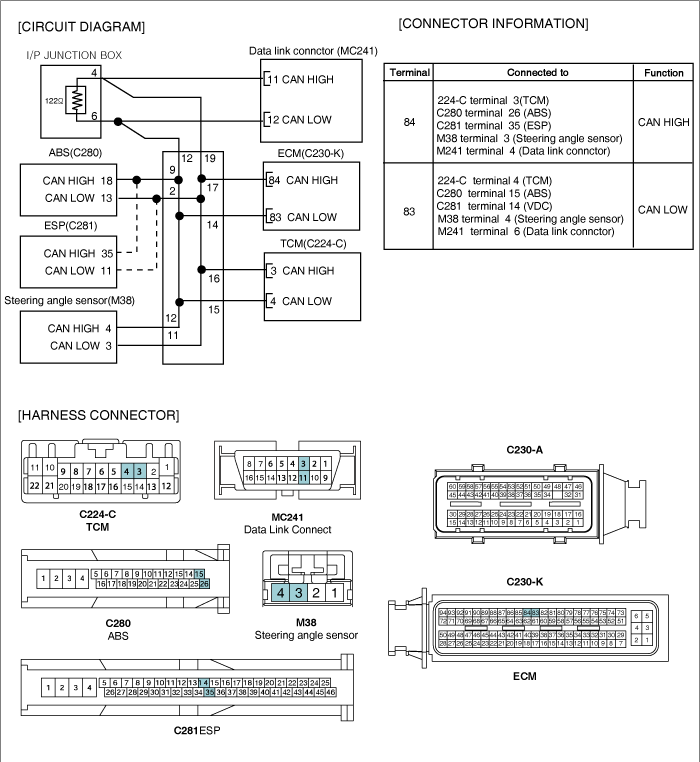
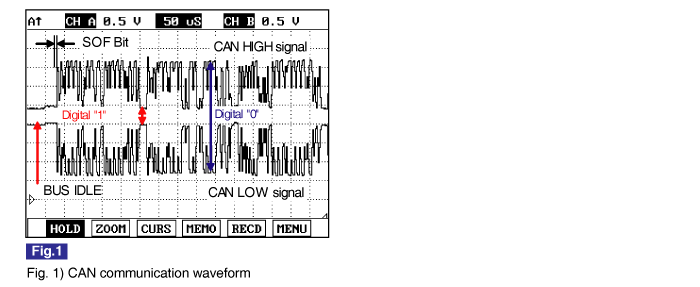
Monitoring CAN HIGH and LOW simultaneously is important in monitoring CAN communication waveform. When CAN HIGH signal rise to 3.5V and LOW signal drops to 1.5V - voltage difference between HIGH and LOW signal is 2V - at BUS IDLE state(DIGITAL "1") whose reference voltage is 2.5V, "0" is recognized. Besides, comparing HIGH and LOW signal if opposite waveform is detected with the reference voltage of 2.5V, Check if current cam signal transfers correctly.
Continuous "0"signal above 6BIT means the occurence of error in CAN communication. 1BIT is easily distinguished as calculating the time when "SOF"(START OF FRAME) which notifies the start of frame occurs. Check if "0"signal above 6BIT is detected continuously when monitoring CAN communication waveform.

Connect scantool to data link connector(DLC).
Engine "ON".
Monitor the "CAN COMMUNICATION SERVICE DATA (ENGINE RPM, VEHICLE SPEED SENSOR, THROTTLE P. SENSOR)" parameters on the scantool.

Does "CAN BUS LINE DATA " follow the reference data?

▶ Fault is intermittent caused by poor contact in the sensor's and/or TCM(PCM)'s connector or was repaired and TCM(PCM) memory was not cleared. Thoroughly check connectors for looseness, poor connection, bending, corrosion, contamination, deterioration or damage. Repair or replace as necessary and go to "Verification of Vehicle Repair" procedure .

▶ Go to "Terminal&Connector Inspection" procedure.
Electrical systems consist of a lot of harness and connectors, poor connection of terminals can cause various problems and damge of component.
Perform checking procedure as follows.
Check damage of harness and terminals : Check terminals for contact resistance, corrosion and deformation.
Check connecting condition of ECM and component connector : Check terminal seperation, damage of locking device and connecting condition between terminal and wiring.
Disconnect the pin which requires checking at male connector and insert it to the terminal at female connector for checking connecting condition. ( after checking, reconnect the pin at correct position. )
Is the problem found?

▶ Repair the trouble causing part and go to "Verification of Vehicle Repair".

▶ Go to "Power Circuit Inspection" as follows.
Check CAN BUS resistance
IG KEY "OFF", ENGINE "OFF"
Measure the resistance between diagnostic connector 3 and 11. (TEST 1)
Disconnect ECM, TCM, ABS(ESP), and Steering angle sensor connector.
Measure the resistance between diagnostic connector 3 and 11. (TEST 2)

Specification : Both ECM and TCM connected : 60 ± 3Ω (Test 1)
Both ECM and TCM disconnected : 120 ± 3Ω (Test 2)
Is CAN BUS resistance within the specification?

▶ Go to "2.Check short to ground in CAN BUS" as follows.

▶ Below 10Ω for both conditions(disconnected, connected) : Repair short between CAN BUS and go to "Verification of Vehicle Repair".
▶ 120Ω for both conditions(disconnected, connected) : Go to "4. Check CAN BUS continuity".
▶ Infinite Ω for both conditions(disconnected, connected) :Repair open in CAN communication circuit between DLC terminal and I/P junction box.
Check short to ground in CAN BUS
IG KEY "OFF", ENGINE "OFF"
Disconnect ECM, TCM, ABS(ESP), and Steering angle sensor connector.
Check continuity between DLC terminal 3 and chassis ground. (CAN HIGH)
Check continuity between DLC terminal 11 and chassis ground. (CAN LOW)

Specification : Discontinuity ( Infinite Ω )
Is measured resistance within the specification?

▶ Go to "3. Check short to battery in CAN BUS".

▶ Repair short to ground in circuit and go to "Verification of Vehicle Repair".
Check short to battery in CAN BUS
IG KEY "OFF", ENGINE "OFF"
Disconnect ECM, TCM, ABS(ESP), and Steering angle sensor connector.
IG KEY "ON"
Measure the voltage of DLC terminal 3. (CAN HIGH)
Measure the voltage of DLC terminal 11. (CAN LOW)

Specification : 0.0V~0.1V
Is measured voltage within the specification with both connector disconnected?

▶ Go to"4. Check CAN BUS continuity" as follows.

▶ Repair short to battery and go to "Verification of Vehicle Repair".
Check CAN BUS continuity
IG KEY "OFF", ENGINE "OFF"
Disconnect ECM, TCM, ABS(ESP), and Steering angle sensor connector.
Check continuity between DLC terminal 3 and CAN HIGH terminal of each module.
Check continuity between DLC terminal 11 and CAN LOW terminal of each module.
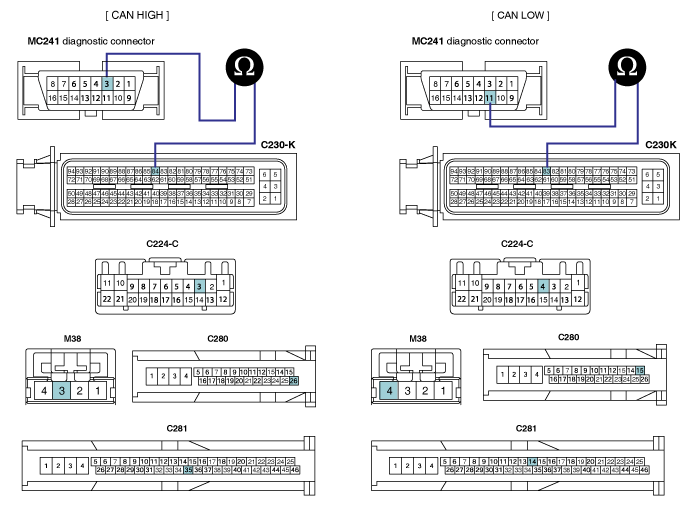
Specification : Continuity(below 1.0Ω )
Is the measured resistance within the specification?

▶ Go to "Component Inspection".

▶ Repair open in CAN BUS and go to "Verification of Vehicle Repair".
Many malfunctions in the electrical system are caused by poor harness and terminals. Faults can also be caused by interference from other electrical systems, and mechanical or chemical damage.
Thoroughly check connectors for looseness, poor connection, bending, corrosion, contamination, deterioration, or damage.
Has a problem been found?

▶ Repair as necessary and then go to "Verification of Vehicle Repair" procedure .

▶ Go to "Signal circuit inspection" procedure .
Ignition "ON" & Engine "OFF".
Disconnect the "TCM" and "ABS ECM" connector.
Measure Resistence between terminal 3 and 4 of the TCM harness connector.
Specification : Approx. 120 ± 10 Ω
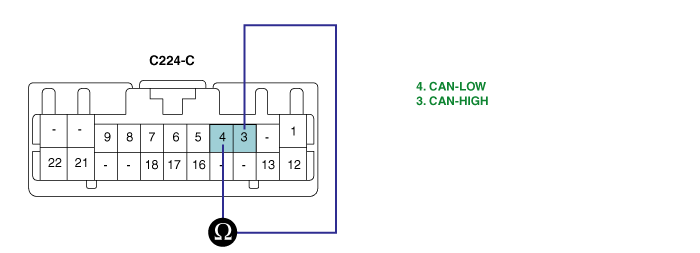
Is measured resistance within specifications?

▶ Substitute with a known-good PCM/TCM and check for proper operation. If the problem is corrected, replace PCM/TCM as necessary and then go to "Verification of Vehicle Repair" procedure.

▶ Check connectors for looseness, poor connection, bending, corrosion, contamination, deterioration or damage of ECM.and then Repair or replace Resistance for CAN communication as necessary and go to "Verification of Vehicle Repair" procedure .
Check CAN communication waveform generation
IG KEY "OFF", ENGINE "OFF"
Disconnect ECM, TCM, ABS(ESP), and Steering angle sensor connector.
Connect 2 channel scope to DLC terminal 3(CAN HIGH) and 11(CAN LOW).
IG KEY "ON" after connecting only "the Control Module(s) to be checked" to CAN BUS.
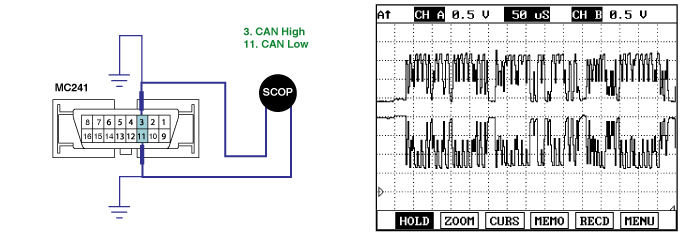
Specification : At IG KEY "ON", the waveform same as "Signal Waveform & Data" of this code generates.
Different from "Signal Waveform & Data", if 1) both CAN HIGH and LOW signal are fixed at 2.5 V or 2) HIGH and LOW signal are fixed at 3.5 V and 1.5 V, respectively, it is due to communication error between modules.
Does correct waveform generate from each module?

▶ Go to "Verification of Vehicle Repair".

▶ Replace the module which generates poor communication waveform, and go to "Verification of Vehicle Repair".
After a repair, it is essential to verify that the fault is corrected.
After connecting Scantool select "DIAGNOSTIC TROUBLE CODES(DTCs)" mode.
Clear recorded DTC using Scantool.
Drive the vehicle within DTC "Enable conditions" in "General information".
After selecting "DIAGNOSTIC TROUBLE CODES(DTCs)" mode and check if DTC is recorded again.
Are any DTCs recorded ?

▶ Go to the DTC guide of recorded NO. in Scantool.

▶ System operates within specification.